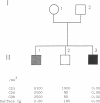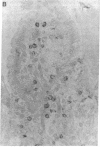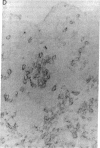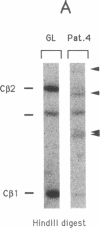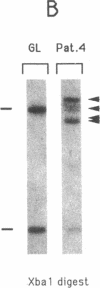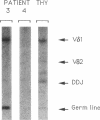Abstract
We report the immunological characteristics of five patients with Omenn's syndrome, a rare inherited immunodeficiency also known as combined immunodeficiency with hypereosinophilia. The syndrome is characterized by T cell infiltration of skin, gut, liver, and spleen leading to diffuse erythroderma, protracted diarrhea, failure to thrive, and hepatosplenomegaly. Blood T cells as well as those infiltrating the skin and gut were found to express activation markers and were partially activated by mitogens but not by antigens. Although the lesions resembled those in graft-versus-host disease, the blood T cells were shown by DNA haplotype analysis using probes revealing variable number of tandem repeats to belong to the patients as well as the T cells infiltrating the gut and skin in one patient. A given T cell subset (TCR alpha beta+, CD4+/CD8+, or TCR gamma delta+) was predominant in each patient, with a specific distribution in the skin lesions. Moreover, the study of T cell receptor beta, gamma, and delta gene rearrangements in four patients revealed oligoclonality involving C beta 1, C beta 2, or different V gamma J gamma or V delta J delta genes. This indicates that restricted heterogeneity of the T cell repertoire, previously reported in one case, is a major feature of this syndrome. The occurrence of alymphocytosis-type severe combined immunodeficiency in the brother of one of the patients suggests that the restricted heterogeneity of T cell receptor gene usage in Omenn's syndrome may arise from leakiness, within the context of a genetically determined faulty T cell differentiation.
Full text
PDF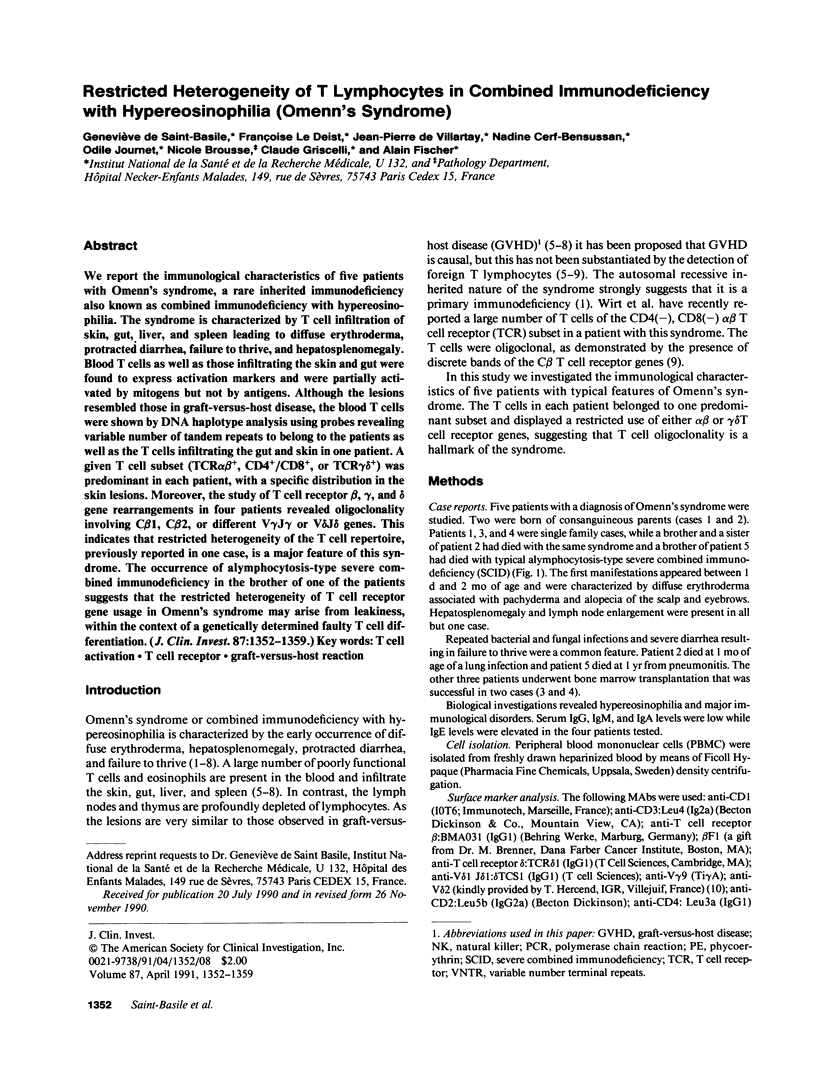


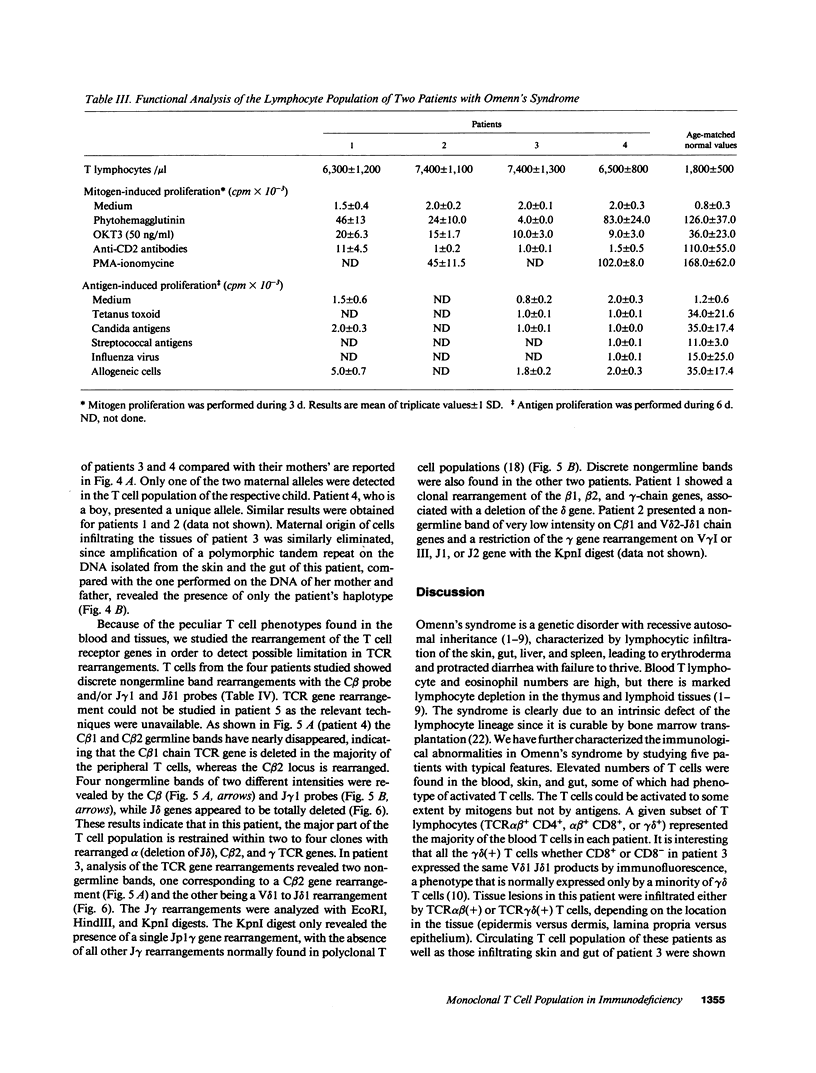
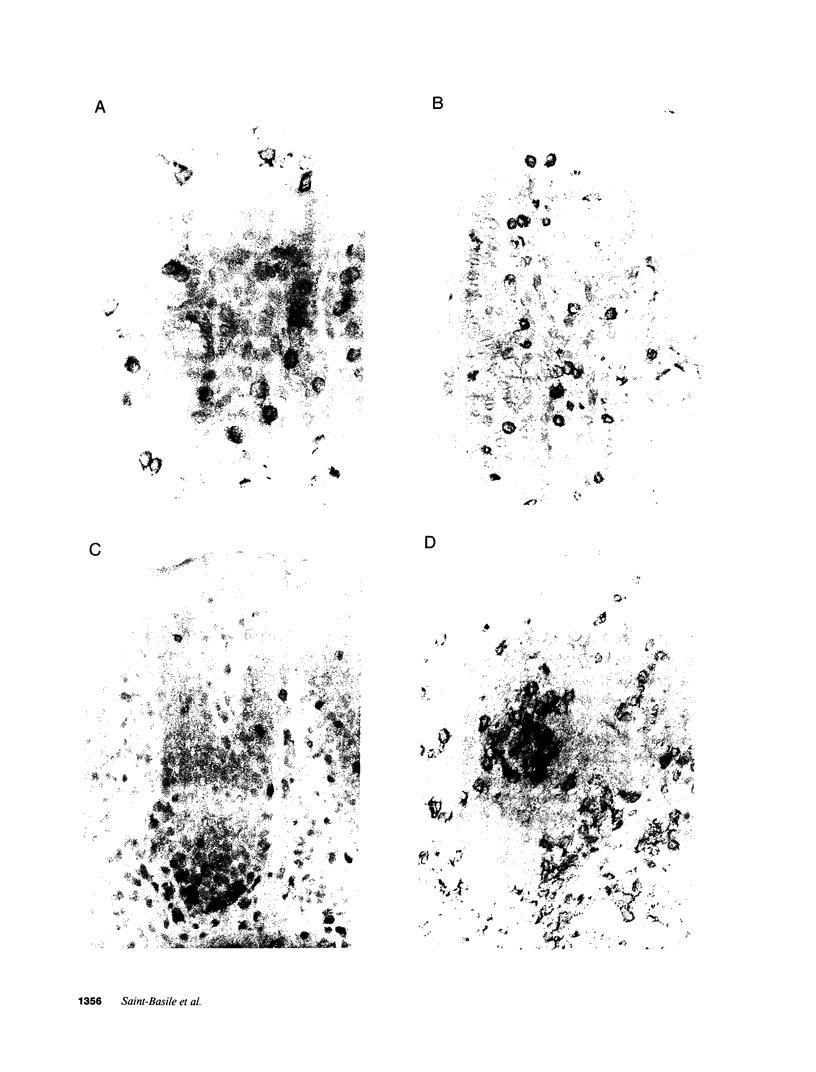
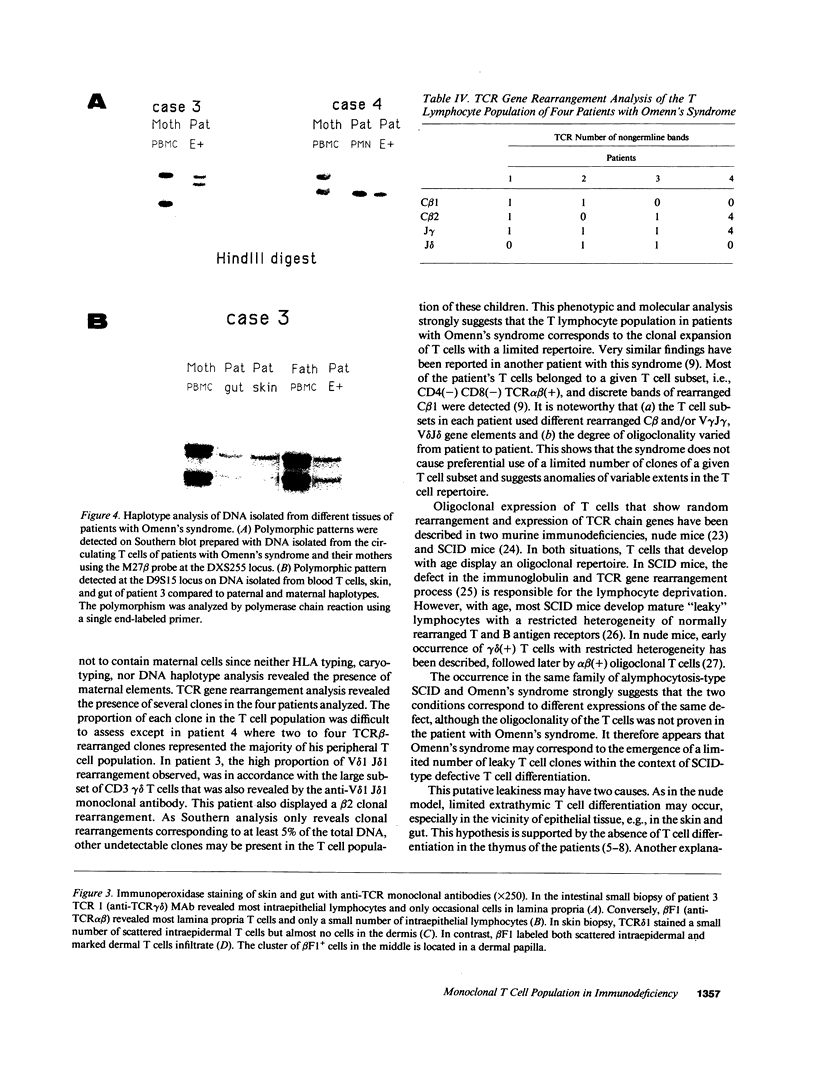

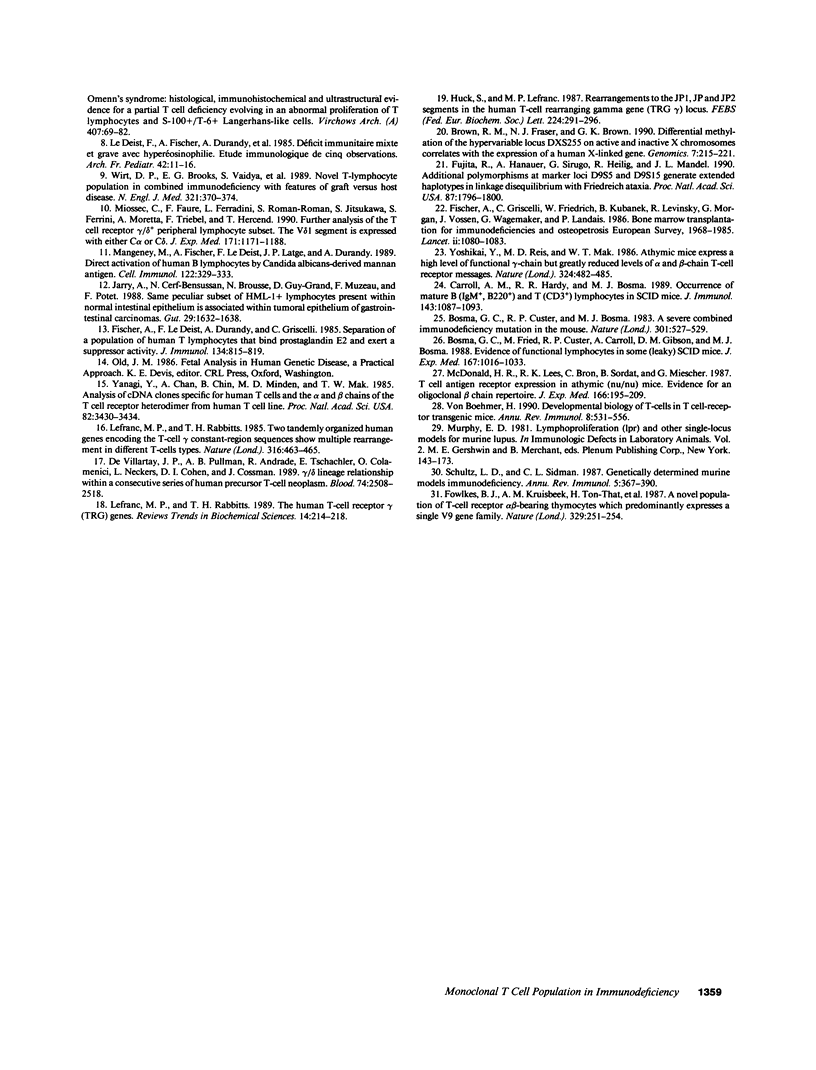
Images in this article
Selected References
These references are in PubMed. This may not be the complete list of references from this article.
- Barth R. F., Vergara G. G., Khurana S. K., Lowman J. T., Beckwith J. B. Rapidly fatal familial histiocytosis associated with eosinophilia and primary immunological deficiency. Lancet. 1972 Sep 9;2(7776):503–506. doi: 10.1016/s0140-6736(72)91904-6. [DOI] [PubMed] [Google Scholar]
- Bosma G. C., Custer R. P., Bosma M. J. A severe combined immunodeficiency mutation in the mouse. Nature. 1983 Feb 10;301(5900):527–530. doi: 10.1038/301527a0. [DOI] [PubMed] [Google Scholar]
- Bosma G. C., Fried M., Custer R. P., Carroll A., Gibson D. M., Bosma M. J. Evidence of functional lymphocytes in some (leaky) scid mice. J Exp Med. 1988 Mar 1;167(3):1016–1033. doi: 10.1084/jem.167.3.1016. [DOI] [PMC free article] [PubMed] [Google Scholar]
- Brown R. M., Fraser N. J., Brown G. K. Differential methylation of the hypervariable locus DXS255 on active and inactive X chromosomes correlates with the expression of a human X-linked gene. Genomics. 1990 Jun;7(2):215–221. doi: 10.1016/0888-7543(90)90543-4. [DOI] [PubMed] [Google Scholar]
- Carroll A. M., Hardy R. R., Bosma M. J. Occurrence of mature B (IgM+, B220+) and T (CD3+) lymphocytes in scid mice. J Immunol. 1989 Aug 15;143(4):1087–1093. [PubMed] [Google Scholar]
- Cederbaum S. D., Niwayama G., Stiehm E. R., Neerhout R. C., Ammann A. J., Berman W., Jr Combined immunodeficiency presenting as the Letterer-Siwe syndrome. J Pediatr. 1974 Oct;85(4):466–471. doi: 10.1016/s0022-3476(74)80446-4. [DOI] [PubMed] [Google Scholar]
- Cohen A., Mansour A., Dosch H. M., Gelfand E. W. Association of a lymphocyte purine enzyme deficiency (5'-nucleotidase) with combined immunodeficiency. Clin Immunol Immunopathol. 1980 Feb;15(2):245–250. doi: 10.1016/0090-1229(80)90035-5. [DOI] [PubMed] [Google Scholar]
- Fischer A., Griscelli C., Friedrich W., Kubanek B., Levinsky R., Morgan G., Vossen J., Wagemaker G., Landais P. Bone-marrow transplantation for immunodeficiencies and osteopetrosis: European survey, 1968-1985. Lancet. 1986 Nov 8;2(8515):1080–1084. doi: 10.1016/s0140-6736(86)90477-0. [DOI] [PubMed] [Google Scholar]
- Fischer A., Le Deist F., Durandy A., Griscelli C. Separation of a population of human T lymphocytes that bind prostaglandin E2 and exert a suppressor activity. J Immunol. 1985 Feb;134(2):815–819. [PubMed] [Google Scholar]
- Fowlkes B. J., Kruisbeek A. M., Ton-That H., Weston M. A., Coligan J. E., Schwartz R. H., Pardoll D. M. A novel population of T-cell receptor alpha beta-bearing thymocytes which predominantly expresses a single V beta gene family. Nature. 1987 Sep 17;329(6136):251–254. doi: 10.1038/329251a0. [DOI] [PubMed] [Google Scholar]
- Fujita R., Hanauer A., Sirugo G., Heilig R., Mandel J. L. Additional polymorphisms at marker loci D9S5 and D9S15 generate extended haplotypes in linkage disequilibrium with Friedreich ataxia. Proc Natl Acad Sci U S A. 1990 Mar;87(5):1796–1800. doi: 10.1073/pnas.87.5.1796. [DOI] [PMC free article] [PubMed] [Google Scholar]
- Huck S., Lefranc M. P. Rearrangements to the JP1, JP and JP2 segments in the human T-cell rearranging gamma gene (TRG gamma) locus. FEBS Lett. 1987 Nov 30;224(2):291–296. doi: 10.1016/0014-5793(87)80472-6. [DOI] [PubMed] [Google Scholar]
- Jarry A., Cerf-Bensussan N., Brousse N., Guy-Grand D., Muzeau F., Potet F. Same peculiar subset of HML1 + lymphocytes present within normal intestinal epithelium is associated with tumoral epithelium of gastrointestinal carcinomas. Gut. 1988 Dec;29(12):1632–1638. doi: 10.1136/gut.29.12.1632. [DOI] [PMC free article] [PubMed] [Google Scholar]
- Le Deist F., Fischer A., Durandy A., Arnaud-Battandier F., Nezelof C., Hamet M., de Prost Y., Griscelli C. Déficit immunitaire mixte et grave avec hyperéosinophilie. Etude immunologique de cinq observations. Arch Fr Pediatr. 1985 Jan;42(1):11–16. [PubMed] [Google Scholar]
- Lefranc M. P., Rabbitts T. H. The human T-cell receptor gamma (TRG) genes. Trends Biochem Sci. 1989 Jun;14(6):214–218. doi: 10.1016/0968-0004(89)90029-7. [DOI] [PubMed] [Google Scholar]
- MacDonald H. R., Lees R. K., Bron C., Sordat B., Miescher G. T cell antigen receptor expression in athymic (nu/nu) mice. Evidence for an oligoclonal beta chain repertoire. J Exp Med. 1987 Jul 1;166(1):195–209. doi: 10.1084/jem.166.1.195. [DOI] [PMC free article] [PubMed] [Google Scholar]
- Mangeney M., Fischer A., Le Deist F., Latgé J. P., Durandy A. Direct activation of human B lymphocytes by Candida albicans-derived mannan antigen. Cell Immunol. 1989 Sep;122(2):329–337. doi: 10.1016/0008-8749(89)90081-6. [DOI] [PubMed] [Google Scholar]
- Miossec C., Faure F., Ferradini L., Roman-Roman S., Jitsukawa S., Ferrini S., Moretta A., Triebel F., Hercend T. Further analysis of the T cell receptor gamma/delta+ peripheral lymphocyte subset. The V delta 1 gene segment is expressed with either C alpha or C delta. J Exp Med. 1990 Apr 1;171(4):1171–1188. doi: 10.1084/jem.171.4.1171. [DOI] [PMC free article] [PubMed] [Google Scholar]
- OMENN G. S. FAMILIAL RETICULOENDOTHELIOSIS WITH EOSINOPHILIA. N Engl J Med. 1965 Aug 19;273:427–432. doi: 10.1056/NEJM196508192730806. [DOI] [PubMed] [Google Scholar]
- Ochs H. D., Davis S. D., Mickelson E., Lerner K. G., Wedgwood R. J. Combined immunodeficiency and reticuloendotheliosis with eosinophilia. J Pediatr. 1974 Oct;85(4):463–465. doi: 10.1016/s0022-3476(74)80445-2. [DOI] [PubMed] [Google Scholar]
- Ruco L. P., Stoppacciaro A., Pezzella F., Mirolo M., Uccini S., Barsotti P., Cassano A. M., Boner A. L., Businco L., Di Fazio A. The Omenn's syndrome: histological, immunohistochemical and ultrastructural evidence for a partial T cell deficiency evolving in an abnormal proliferation of T lymphocytes and S-100 +/T-6 + Langerhans-like cells. Virchows Arch A Pathol Anat Histopathol. 1985;407(1):69–82. doi: 10.1007/BF00701330. [DOI] [PubMed] [Google Scholar]
- Shultz L. D., Sidman C. L. Genetically determined murine models of immunodeficiency. Annu Rev Immunol. 1987;5:367–403. doi: 10.1146/annurev.iy.05.040187.002055. [DOI] [PubMed] [Google Scholar]
- Wirt D. P., Brooks E. G., Vaidya S., Klimpel G. R., Waldmann T. A., Goldblum R. M. Novel T-lymphocyte population in combined immunodeficiency with features of graft-versus-host disease. N Engl J Med. 1989 Aug 10;321(6):370–374. doi: 10.1056/NEJM198908103210606. [DOI] [PubMed] [Google Scholar]
- Wyss M., von Fliedner V., Jacot-Des-Combes E., Jeannet M., Despont J. P., Kapanci Y., Cox J. N. A lymphoproliferative syndrome, "cutaneous dystrophy" and combined immune deficiency with lack of helper T-cell factor. Clin Immunol Immunopathol. 1982 Apr;23(1):34–49. doi: 10.1016/0090-1229(82)90068-x. [DOI] [PubMed] [Google Scholar]
- Yanagi Y., Chan A., Chin B., Minden M., Mak T. W. Analysis of cDNA clones specific for human T cells and the alpha and beta chains of the T-cell receptor heterodimer from a human T-cell line. Proc Natl Acad Sci U S A. 1985 May;82(10):3430–3434. doi: 10.1073/pnas.82.10.3430. [DOI] [PMC free article] [PubMed] [Google Scholar]
- Yoshikai Y., Reis M. D., Mak T. W. Athymic mice express a high level of functional gamma-chain but greatly reduced levels of alpha- and beta-chain T-cell receptor messages. Nature. 1986 Dec 4;324(6096):482–485. doi: 10.1038/324482a0. [DOI] [PubMed] [Google Scholar]
- de Villartay J. P., Pullman A. B., Andrade R., Tschachler E., Colamenici O., Neckers L., Cohen D. I., Cossman J. Gamma/delta lineage relationship within a consecutive series of human precursor T-cell neoplasms. Blood. 1989 Nov 15;74(7):2508–2518. [PubMed] [Google Scholar]
- von Boehmer H. Developmental biology of T cells in T cell-receptor transgenic mice. Annu Rev Immunol. 1990;8:531–556. doi: 10.1146/annurev.iy.08.040190.002531. [DOI] [PubMed] [Google Scholar]



